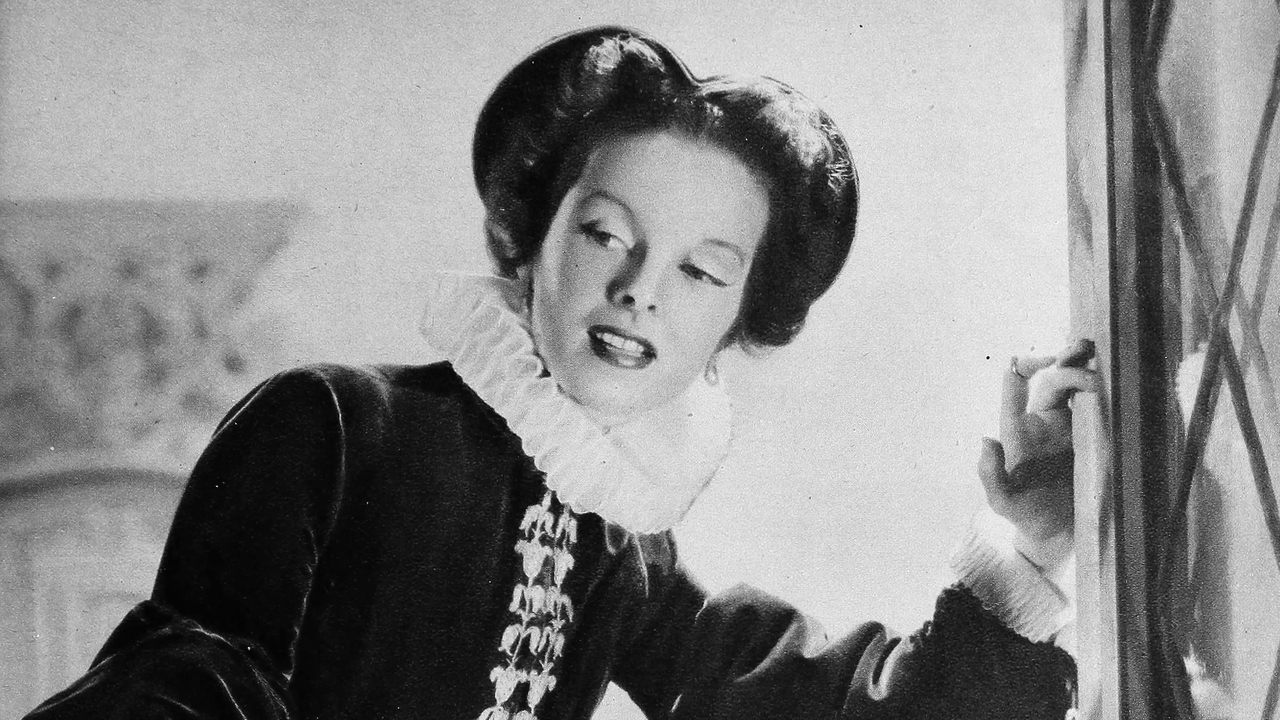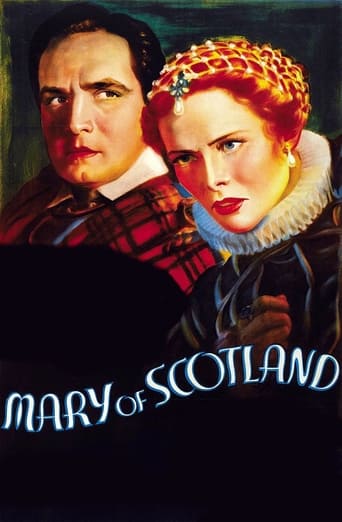

Pretty Good
... View MoreI didn’t really have many expectations going into the movie (good or bad), but I actually really enjoyed it. I really liked the characters and the banter between them.
... View MoreThe story, direction, characters, and writing/dialogue is akin to taking a tranquilizer shot to the neck, but everything else was so well done.
... View MoreBlistering performances.
... View MoreBeing Scottish myself and somewhat familiar with the historical personnel and events depicted here, I was curious as to how the great John Ford would depict the life of a famous personage in my country's history. Well, the answers are inaccurately and boringly I'd have to say.Firstly, for every other actor's inaccurate attempt at the accent there's another who doesn't even try at all, Katherine Hepburn's title character least of all. Reversing the trend of Britain colonising America, here in Hollywood's version of the 17th Century we have Kate setting foot proclaiming and declaiming in her barely watered down native Philadelphia accent. That said, she does put a lot into her role with much handwringing and top-lip trembling as Mary's woes increase throughout the film until her execution at the end. However her end is a long time coming and while Ford tries to cover all the main incidents of her life in Scotland, including her ill-fated alliances with the drunken sot Lord Darnley, her noble champion and her doomed servant David Rizzio, her pawn like usage by her council if Scottish lairds and of course the enmity borne her by Queen Elizabeth, but it's all very done haphazardly and disjointed,y giving no real flow to proceedings. In support Fredric March at least attempts a Scottish accent although it gets stuck half way across the Atlantic although hs wife as Elizabeth does better in her role. Ford famously lost interest in the movie during filming even allowing Hepburn to (very obviously) direct a lengthy love scene with March, but the artist in him still wins through occasionally with some impressive set constructions, high perspective shooting views and atmospheric chiaroscuro lighting effects, plus the final scene of Mary ascending to the guillotine is genuinely powerful.All together though there are too many characters and not enough action for the film to flow so that it seems longer than its already lengthy running-time. To the best of my knowledge Ford never attempted historical biography again in his long career which shows if nothing else his self-awareness of his own strengths and weaknesses.Rumours that he later referred to this outing as "The Scottish film" are however unfounded.
... View MoreThe life story of Mary, Queen of Scots is a thoroughly engaging one. I recommend anyone who wants to know more about the history while being entertained at the same time to check out the two Jean Plaidy books, ROYAL ROAD TO FOTHERINGAY and its sequel, THE CAPTIVE QUEEN OF SCOTS - two great little novels that tell you all there is to know.MARY OF Scotland is an all-too Hollywoodised version of the story that suffers from an exceptionally overlong running time, unfortunately. It's strange, because some parts of the production are exceptionally slow and boring, while 19 years of history is condensed into about five minutes. There are a few eventful bits but for the most part this is a drag.The director is none other than John Ford, but despite the presence of such a cinematic luminary, he seems uninterested in the material which is lifeless as a result. Katharine Hepburn is also a disappointment as Mary herself, singularly failing to make the queen sympathetic in any way. Fredric March does what he can as Bothwell, and there are nice little roles for John Carradine and Moroni Olsen, but it's not enough.I particularly disliked the way that some good little bits of history are omitted or simplified for no apparent reason. For instance, Douglas Walton's final scene didn't happen that way at all and much more drama could have been made of it. Instead all the focus is on the talk and its incessant and goes nowhere. The definitive story of Mary, Queen of Scots this certainly isn't.
... View MoreMy comment is not positive, therefore it will be brief. This story is far away from the real one. In the film Bothwell is not the ambitious man whom Mary loved, the relationship of Mary with her English "sister" is touched shallowly showing Elizabeth, the queen, as an evil but avoiding to show the complexity of the English - Scotish problem at that time and the influence of France on the ongoing events there. Moray, the Mary's half brother, was a very smart man and knew how to move himself with his well invented intrigues, in the film one cannot see much of that. The film was made to show Mary as a heroe, killed because England wanted to do that. Very simple, in my opinion, and not good for educating on history the new generation. Katharine Hepburn played well the role given to her, Fredric March and John Carradine performances were poor.
... View MoreMARY OF SCOTLAND, caught up in intrigues over which she has no control, finds herself at the mercy of powerful forces that wish her ill.John Ford crafted this meticulous, thoughtful study into the life of the Scottish Queen and the trials & tribulations which buffeted her. With a complicated plot and a very large cast, the film presupposes a certain amount of intelligence on the part of its viewers, as well as an interest in the history of Great Britain. The film is not easy to watch - this is, after all, an historical drama, not a musical comedy - but the viewer's attention should be paid off in the end. Very fine production values also help greatly in the movie's appreciation.Katharine Hepburn is luminous & regal in the title role. Continuing in the tradition of formidable actresses of the 1930's who played queens on the screen (Colbert, Garbo, Dietrich, Shearer, Robson, Davis) Hepburn gives a strong portrayal of the stubborn, independently minded Scottish monarch. Kate makes the viewer at once feel an engaging interest in this poor lady, so beset by the slings & arrows of outrageous fortune.' Wisely not speaking in a brogue - the real Mary probably didn't either - Hepburn uses her remarkable face & voice to make this long-dead historical figure come alive.As the Earl of Bothwell, Mary's 3rd husband, Fredric March provides a sturdy hero worth cheering. Here is a man willing to confront any danger for the sake of the woman he loves. If the real Bothwell was perhaps not quite so noble, no matter. March breathes vibrant, pulsing life into the character and embodies him with real strengths & virtues.A large & exceptional cast give fine support to the principals. Some deserve special mention:John Carradine as Mary's tragic Italian secretary, Rizzio; Douglas Walton as Lord Darnley, Mary's repugnant 2nd husband; Ian Keith as her unscrupulous half-brother, the Lord Moray. Florence Eldridge stands out in her portrayal of the conflicted Queen Elizabeth.Moroni Olsen as a fiery John Knox; Donald Crisp as a loyal old laird; Ralph Forbes & Alan Mowbray as Elizabeth's ambassadors; and dear old Mary Gordon as a baby nurse - all have their brief moments to shine.Lionel Belmore & Doris Lloyd (with an unbilled Bobs Watson as their son) play poor fisher folk who give Mary much needed succor. Ivan Simpson & Nigel de Brulier play two of the wicked English judges who condemn Mary to death.But it is Hepburn the viewer remembers longest. Her shining eyes & majestic mien remain in the mind for a very long time***********************The circumstances surrounding the murder of David Rizzio are so well documented that it is somewhat surprising that Ford did not stick more scrupulously to the facts. Darnley and his fellow conspirators entered the Queen's apartments via a private, narrow staircase, hidden in the wall, which communicated directly with Mary's rooms. There is no indication that her bodyguard troops were slain as well, as the film depicts.The script is at pains to keep the Earl of Bothwell a noble hero and uninvolved in Darnley's murder. However, there's little doubt of Bothwell's guilt in the affair. Darnley was not killed outright by the massive explosion - rather he was found, terribly hurt but still alive, lying in a nearby field. He was quickly strangled.The movie does not make clear that it was in Denmark where Bothwell died in prison in 1578. Mary had divorced him in 1570.Unlike the relatively short time depicted in the film, Mary was actually a captive of Elizabeth for 19 years, outliving Bothwell by nine years. Elizabeth & Mary never met - it makes good film drama, but it didn't happen.
... View More